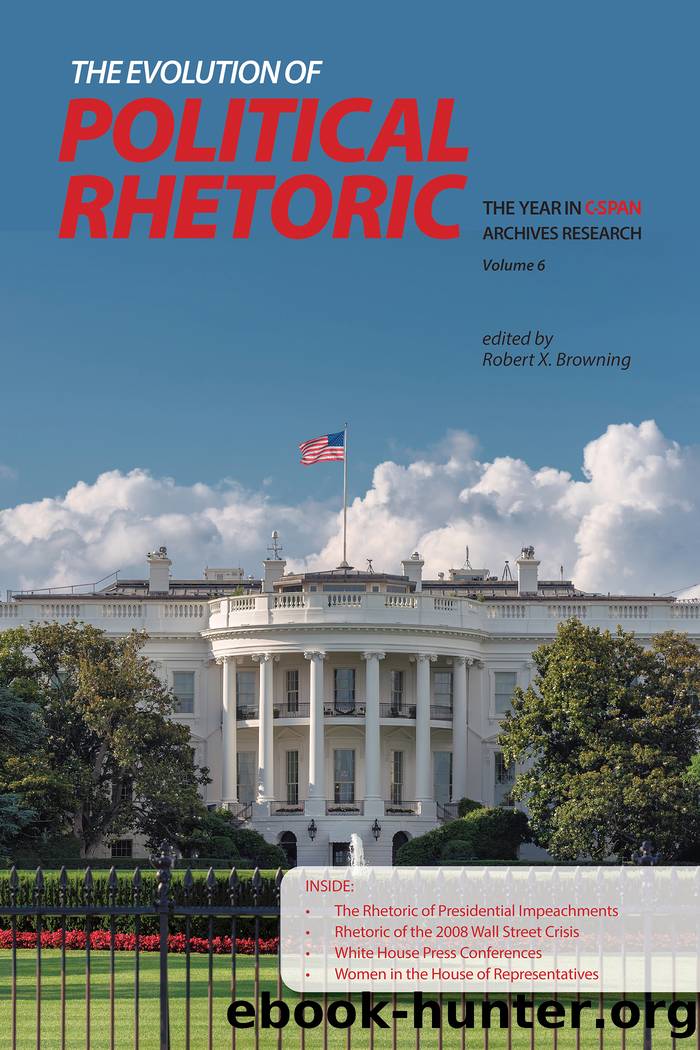The Evolution of Political Rhetoric: The Year in C-SPAN Archives Research, Volume 6 by Robert X. Browning

Author:Robert X. Browning [Browning, Robert X.]
Language: eng
Format: epub
ISBN: 9781612496214
Google: KgY7zQEACAAJ
Amazon: B08BTY7SHH
Barnesnoble: B08BTY7SHH
Goodreads: 55760109
Publisher: Purdue University Press
Published: 2020-12-15T00:00:00+00:00
A RESEARCH LACUNA
For the vast amount of rhetorical scholarship focused on the president and the presidency, we were surprised to find such a small amount of scholarship on the campaign announcement speech. What we did find says more about the strange nature of this form of public address than it does about the speeches themselves. Furthermore, many sites of presidential research and on presidential figures do not clearly or obviously archive the announcement speech among the other papers of a former president or national political figure. This suggests that campaign announcement speeches are not commonly considered to be part of presidential rhetoric studies.
Ryan Neville-Shepard (2014) writes about campaign announcements for the purpose of crafting a genre of third-party political candidate discourse. His essay indicates the lack of scholarship on campaign announcements when he has to rely on Time magazine to provide evidence for a diachronic structure to these speeches. Although Neville-Shepard gives careful attention to campaign announcements, he focuses only on third-party candidates, arguing that disruption of the traditional campaign announcement is one of the few ways third-party candidates can get solid attention to their efforts. He takes a traditional announcement model from Trent et al. (2011), who outline the purpose of the campaign announcement in very functional termsânamely that these speeches serve to attract attention, establish reasons for the candidacy, request support, and prove that the candidate has the background or experience for the job. Neville-Shepard attends to the campaign announcement speech precisely because it is viewed as outside the normal and more studied presidential forms of public address. He does this to make his claim about third-party candidates, not to examine or study the form of the announcement itself.
Jeffrey Tullis (1987) famously argued that the modern presidency is constituted rhetorically. Instead of the 19th-century mode of presidential discourse, often aimed at the Congress, 20th-century presidents aimed their rhetoric at the people directly, to address their needs, perform leadership, and to gain support for their policies. This shift in the way presidents speak and write was significant to Tullis, so much so that he argued there might be a âsecond Constitutionâ operating for 20th-century presidents, where the president might attempt to persuade the people as to what issues matter, what issues are important, and therefore circumvent the role of congressional representatives. Tullis has since softened that view, arguing that all presidencies are rhetorical, in the sense that presidents define their leadership role, and their relationship to the people and government, through their public address (Tullis, 1996). However, neither in The Rhetorical Presidency nor in his reflective 1996 essay did Tullis mention campaign announcement speeches. If rhetoric is so vital to the construction of what counts as presidential, these speeches seem central. But they are ignored by Tullis, and by other scholars who investigate the role of public address in the formation of the office of president.2 For those who run for this office, constituting themselves as equal to the task, or as presidential themselves, is a discursive role played out first on the national stage through speech.
Download
This site does not store any files on its server. We only index and link to content provided by other sites. Please contact the content providers to delete copyright contents if any and email us, we'll remove relevant links or contents immediately.
The Secret History by Donna Tartt(18694)
The Social Justice Warrior Handbook by Lisa De Pasquale(12069)
Thirteen Reasons Why by Jay Asher(8717)
This Is How You Lose Her by Junot Diaz(6690)
Weapons of Math Destruction by Cathy O'Neil(6069)
Zero to One by Peter Thiel(5618)
Beartown by Fredrik Backman(5533)
The Myth of the Strong Leader by Archie Brown(5358)
The Fire Next Time by James Baldwin(5185)
How Democracies Die by Steven Levitsky & Daniel Ziblatt(5083)
Promise Me, Dad by Joe Biden(5029)
Stone's Rules by Roger Stone(4981)
100 Deadly Skills by Clint Emerson(4785)
A Higher Loyalty: Truth, Lies, and Leadership by James Comey(4768)
Rise and Kill First by Ronen Bergman(4643)
Secrecy World by Jake Bernstein(4584)
The David Icke Guide to the Global Conspiracy (and how to end it) by David Icke(4539)
The Farm by Tom Rob Smith(4397)
The Doomsday Machine by Daniel Ellsberg(4366)
